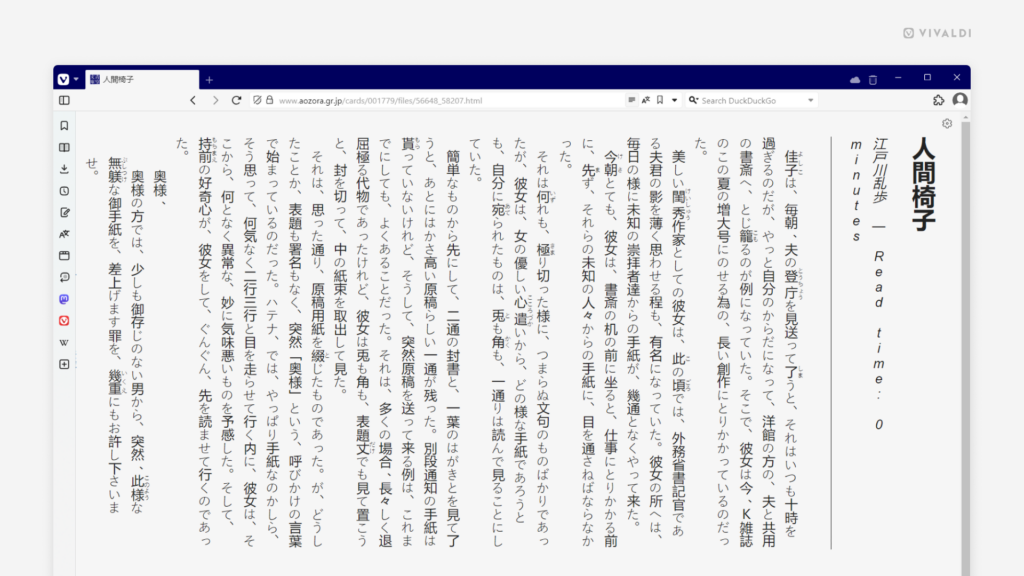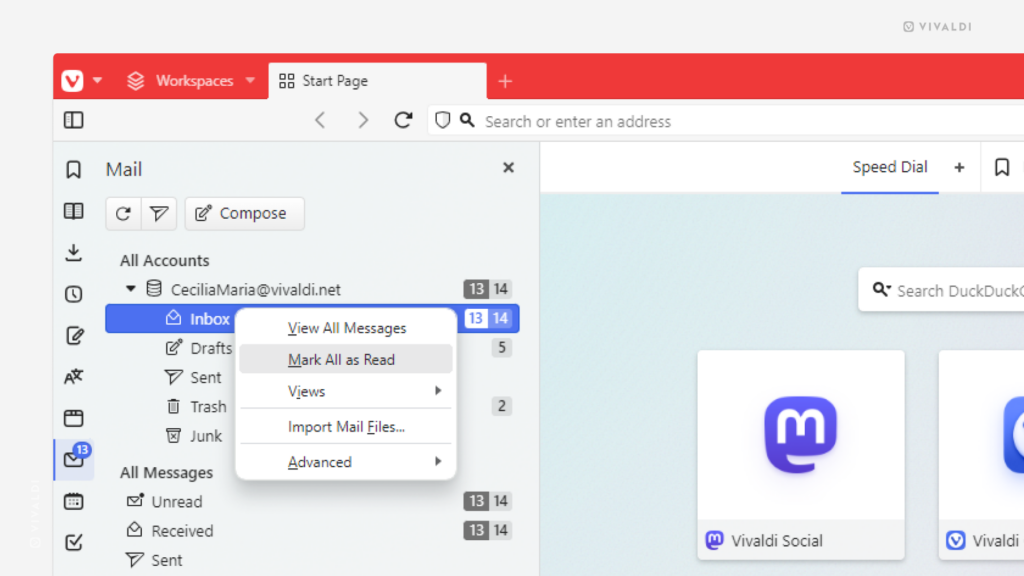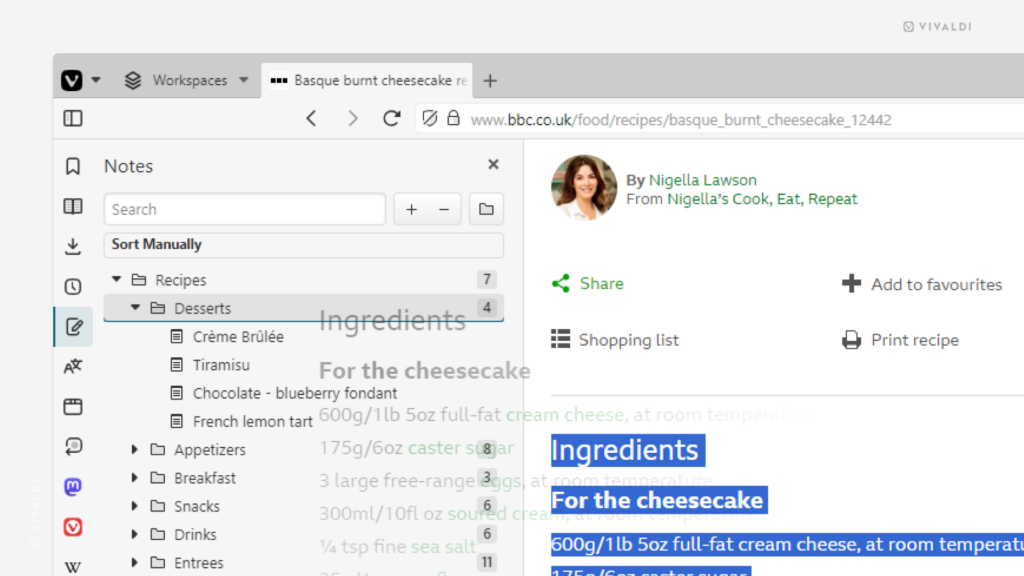Desktop Tips
Tip #483
May 7, 2024
Switch between time periods in the Vivaldi Calendar using your mouse’s scroll wheel.
While viewing and editing your events and tasks in the Vivaldi Calendar you’ll probably need to check things in the past and future.
To do that, you can use the < and > buttons on either side of the “Today” button in the top left corner of the Calendar page or you can press the up and down arrow keys on your keyboard. But there’s a new and very convenient option available in the Vivaldi Calendar – using your mouse’s scroll wheel.
Scroll up to view previous time periods and scroll down to go to the upcoming ones. It works in all Calendar views from single-day view up to the year view.
Tip #481
May 3, 2024
Cycle through Tabs either in recently used order or in the order they’re listed on the Tab Bar.
Cycling through tabs using Keyboard Shortcuts or the scroll wheel of your mouse while holding down the right mouse button is a convenient way to switch tabs. In Vivaldi, you have the power to choose in which order the tabs are cycled through.
To make your choice:
- Go to Settings > Tabs > Tab Features > Tab Cycling.
- Choose between “Cycle in Recently Used Order” or “Cycle in Tab Order”.
Bonus! See how to enable the visual Tab Cycler in Tip #267.
Tip #480
May 2, 2024
Log in to your Vivaldi account from mail and calendar clients using an app password.
If you’ve enabled Two-Factor Authentication for your Vivaldi account, then you need to use an app password when adding your account to mail and calendar clients, such as Vivaldi Mail and Vivaldi Calendar.
To generate an app password:
- Log in to your Vivaldi account on Vivaldi.net and go to the profile.
- Go to the Two-Factor Authentication management page and verify your identity with the login password.
- If you have at least one 2FA method set up, you’ll see an option to create App Passwords, go to that page.
- Select the type of app (mail, calendar, or both) you want to create the password for.
- Give it a name, so you’ll recognize which apps and clients you’ve generated passwords for.
- Copy the password, enter it on the login page of the client, and store the password in a safe location as this is the only time the password will be shown to you.

Tip #477
April 26, 2024
Double-click on the Tab Bar to open a new tab.
Everyone can find a way to open a new tab in Vivaldi that fits their habits. You can click the + button on the Tab Bar, go through the main menu, or use one of the many shortcuts. But there’s another lesser-known option.
When you have the Tab Bar on the side of the window or at the bottom, you can just double-click on an empty area on the Tab Bar and a new tab will open. When you have the Tab Bar on top, then a double-click will maximize the window or revert it to its previous size, but you can get double-clicks to open new tabs on a top positioned Tab Bar when you turn on Native Window from Window Appearance settings.
Tip #476
April 25, 2024
Enable compact layout of menus if you prefer your menu items to be more tight-knit.
Vivaldi 6.7 introduced a new design to the browser’s main and context menus. Among other changes, each menu item is given more space (great for when your screen supports touch interactions). If you prefer the previous design, you can enable it with a quick setting change.
To enable compact menus:
Tip #473
April 22, 2024
Enable “Focus All Controls and Links” to be able to use the Tab key to go through more than just input fields on a web page.
When you press the Tab key, by default, it only focuses on input fields (search, login, forms, etc.) and a few other elements on the page. But by changing one setting you can browse through everything on a web page (in addition to the aforementioned, input fields, menus, links, etc.)
To enable this option:
- Go to Settings > Webpages > Webpage Focus.
- Select “Focus All Controls and Links”.
Tip #470
April 17, 2024
Add your Vivaldi account to the Vivaldi Calendar.
Did you know that in addition to the built-in Calendar client, Vivaldi also offers an online calendar service bundled with Vivaldi Webmail*? You can use it with Vivaldi Calendar and add it to other calendar clients and apps that support CalDAV.
To add your Vivaldi account to Vivaldi Calendar:
- Go to Settings > Calendar > Calendar Accounts.
- Click on + “Add Account”.
- Select Vivaldi.net.
- Give the calendar a name.
- Enter your account’s email address.
- Enter your account’s login password or the app password, if you have Two-Factor Authentication enabled.
- Once logged in, select which calendars you want to sync or hide.
- Finish by clicking “Save Account”.
To add your Vivaldi account to other clients and apps, follow their instructions and check out this Help page for more information.
*New accounts first need to build up reputation to use Vivaldi Webmail and the calendar. More info.
Tip #469
April 16, 2024
Enable vertical Reader View to display texts in Japanese, Chinese, and Korean vertically.
Enabling Reader View helps to read text-heavy pages more easily by removing distractions. To accomodate the readers of vertical text, we’ve also added a setting to display texts in Japanese, Chinese and Korean vertically when Reader View is enabled.
To enable vertical Reader View:
- Go to Settings > Web Pages > Reader.
- Enable “Allow vertical text direction”.

Tip #466
April 11, 2024
Switch Tabs and Tab Stacks using Keyboard Shortcuts.
If you’re a fan of using Keyboard Shortcuts, we have good news for you. Did you know that you can switch between the first few Tabs or Tab Stacks you have open with simple shortcuts?
Use the shortcuts Ctrl + 1, Ctrl + 2, all the way to Ctrl + 8 to switch to the tab or stack corresponding to its position on the Tab Bar. Using Ctrl + 9 will take you to the last open tab or stack. (On macOS, replace the Control key with Command.)
If these shortcuts don’t work for you, you can always assign your own in Settings > Keyboard > Tab and look for “Switch to Tab #”.
Tip #462
April 5, 2024
Mark all messages in a folder as read right in the Mail Panel.
You can open the mail folder, mark each message as read individually, or mark multiple messages as read by selecting some using the Shift or Ctrl key + click, or by selecting them all with the keyboard shortcut Ctrl + A. But you can also mark all messages as read from the Mail Panel without even opening the folder.
To mark a folder full of messages read:
- Open the Mail Panel.
- Right-click on a folder to open the context menu.
- Select “Mark All as Read”.

Tip #461
April 4, 2024
Drag text from a web page to the Notes Panel to create a new note.
Do you like dragging things around instead of going through context menus? There are many things you can do in Vivaldi with drag and drop, one of them is creating notes. You can drag the text from a web page you have open in Vivaldi, but also from other apps you have open on the side.
To create a new note with drag and drop:
- Open the Notes Panel.
- Highlight the text you want to create the note from.
- Drag it to the Notes Panel.
- When you see a line in your Theme‘s highlight color, drop it.
If you open one of the notes, you can also drag additional text to it.

Tip #459
April 2, 2024
Scroll back to the top of the page with Mouse Gestures.
Have you scrolled on a page for a while and now need to get back to the top? You could scroll the same amount in the opposite direction, drag the scrollbar on the side of the window, or use a keyboard shortcut. You can also use Mouse Gestures and simply draw a line anywhere on the page while holding down the right mouse button.
To create a Mouse Gesture for scrolling:
- Go to Settings > Mouse > Gesture Mapping.
- Click on + “New Gesture”.
- Search for “Scroll Page to Top”.
- Click “Next”.
- While holding down the left mouse button, draw the gesture you want to use for the action.
- Click “Save Gesture”.